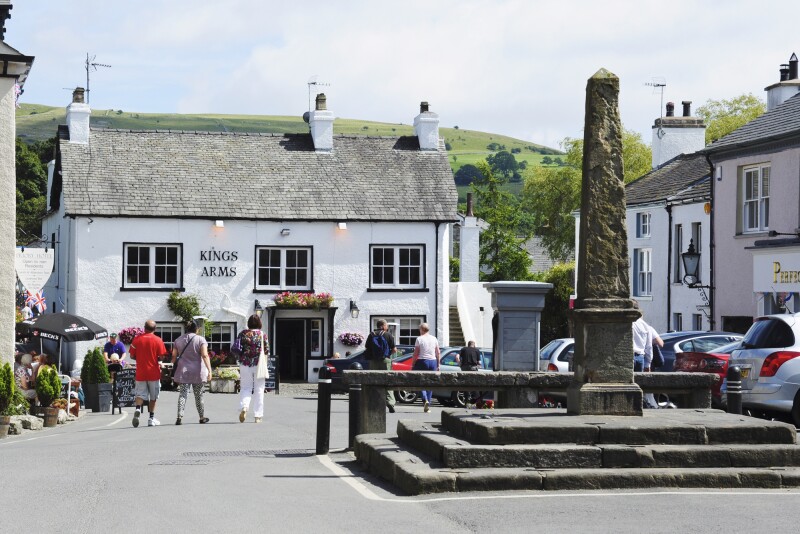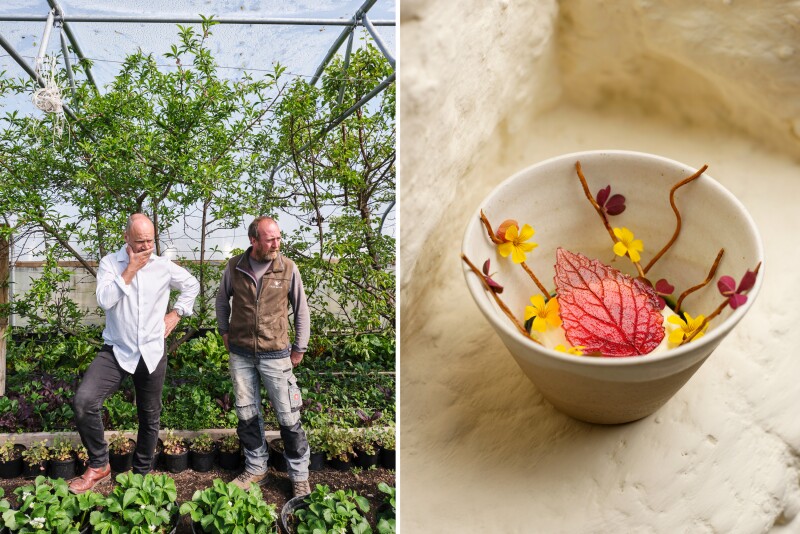The village of Cartmel today is painstakingly picturesque: narrow streets flanked by historic white buildings with pastel shutters, the bubbling River Eea snaking through town, two pubs, a village shop with a bell that tinkles, the soaring 12th-century priory, around which the town initially grew. The village of Cartmel today, with some 300 permanent residents, can be crossed by foot in less than five minutes; then you’re out into the Lake District countryside, livestock farms visible practically everywhere you turn. Throw a stone and you’ll hit a green field dotted with fuzzy, stumbling lambs. Even in February, on mornings when gray cloaks these green fields and a drizzle is semi-permanent, Cartmel is still postcard perfect. But when chef and restaurateur Simon Rogan first arrived in Cartmel 21 years ago, this was not his impression.
“It was,” he says, “depressing as hell.”
At the time, Rogan—who had worked at the one-Michelin-star Lucas Carton in Paris and the boutique inn restaurant Gordleton Mill in Hampshire—was looking to strike out on his own and launch a restaurant according to his vision: one serving food that was comfortable but elevated, one that celebrated the country’s native fruits and vegetables. He would not have considered Cartmel—at the time, in a part of the countryside devastated by foot-and-mouth disease—were it not for the request of a contact, who told him of an 800-year-old blacksmith’s building he suspected Rogan might be interested in.
Rogan was interested in the 13th-century workshop along the River Eea, so much so that he and his wife made an offer on the property on the drive home to London. “We had to sell our house, a car, a stereo, cat, and get a small bank loan, but it was ours,” Rogan says.
In the two decades since he visited Cartmel, Rogan himself has been responsible for much of the town’s transformation, drawing travelers from all around the world to this corner of England for opening L’Enclume, which in 2022 became the first restaurant in northern England to win three Michelin stars—ever. (It retained three Michelin stars in 2023.) Also under his portfolio are Rogan & Co. (relaxed, all-day dining), Aulis (a six-seat chef’s table, adjacent to L’Enclume), Henrock (in the scenic Linthwaite House hotel), plus outposts of restaurants in London and Hong Kong. And though Rogan has since been all over the world, it’s the place he once called “depressing as hell” that he can’t imagine living without.

The village of Cartmel has existed for centuries.
Photo by Peter Moulton/Shutterstock
In September 2002, Rogan and his wife, Penny, opened L’Enclume, which means “anvil” in French and nods to the building’s origin as a blacksmith’s workshop. The early days were simpler: Rogan ran the kitchen and Penny welcomed guests and handled the dining room, which had five tables. Rogan recalls nights worrying over whether they had any guests; luckily, they also operated as something of a bed-and-breakfast, with seven bedrooms for guests to stay in. But Rogan knew that the success of L’Enclume would need to be its meals, not its beds.
He didn’t have to wait long. By 2005, his fine dining restaurant had received its first Michelin star for its emphasis on seasonal produce and farm-to-table cooking; familiar territory, in many ways, for Rogan, who grew up in Southampton, helping his father run his fruit and vegetable stall. In 2013, L’Enclume received its second star. Of the eight years between one and two stars, Rogan admits he had been looking abroad for inspiration—at places like El Bulli in Spain, Narisawa in Japan. “I got really bitten by this idea of shocking people with different theatrics and ingredients and flavor combinations,” he says. “Eventually I got really bored with that and I just thought, This isn’t me. And a few people that were really close to me had a word and said, Look, you’ve had your fun. Now get back to what you’re good at—connecting your restaurant with its surroundings and the natural ingredients of this country.”
Rogan took that to heart, and within a week, he says, he stopped using “foreign” ingredients—anything that couldn’t naturally be grown in England. (Lemons, Rogan admits, were particularly hard to get rid of, but he’s since found other ways of using acidity, including creating vinaigrette out of things like elderflower instead.) A key part of the success has also been the development of Rogan’s own aptly named Our Farm, which has grown in operation in the past decade from an empty field to 12 acres. Today, it is self-sufficient and off-grid, and 84 percent of L’Enclume’s menu comes from the farm. It is a large reason L’Enclume was again in 2023 awarded a Green Michelin star, given to “restaurants at the forefront of the industry when it comes to their sustainable practices”; key is working with sustainable producers, avoiding waste, and eliminating nonrecyclable materials from their work.

The menu at L’Enclume changes seasonally. Rogan also has several other restaurants in the Lake District, including Rogan & Co, which has one Michelin star and offers a more relaxed à la carte menu.
Photo by Cris Barnett
The day I visit—a crisp morning in February—the farm is quiet, dormant, though signs of life are evident. Head farmer John Rowland, who has worked for Rogan for three years, rattles off the farm’s initiatives excitedly as we squelch through mud and duck in and out of greenhouses: 14 types of microgreens, peach trees, greyhound cabbage, gooseberries, black currant, red currant, lovage, nasturtium, oxalis, spinach, leeks, onions, broad beans, Chinese artichokes, shiso, nine different types of kale, mulberry trees. There are three working beehives. Rowland is an advocate of regenerative farming, which is free of pesticides and minimizes soil disturbance and waste; he says they use 200 tons of chicken and horse manure as fertilizer and stops at one point to tap one of the farm’s nine food composters. “This is how farming should be,” he says. “It’s biointensive and biodynamic.”
In Rowland’s three years, the farm has gone from using two of its acres to four. Rowland already has plans to expand, walking me to the border of the property (woodland, rocky) to show me where he’d like to put pigs; then how he’s planted roses to act as a natural wind barrier for future produce. This summer, Our Farm head chef Liam Fitzpatrick says he’d like to even turn part of the farm into a six-seat dining area, with nothing coming from outside the walls, an ethos strengthened by his tenure as former head chef of Rogan & Co. and line cook at L’Enclume.
Adds Rowland: “I’ve worked for a lot of chefs, and they have a garden—a garden you could fit on a postage stamp. But Simon is the only one who’s actually using most of the produce. I love to see that happening.”

From left: Rogan and Rowland assess how things are growing on the farm, which provides a majority of the produce for L’Enclume; a dessert of Yorkshire rhubarb, pumpkin seed, fig leaf, oxalis, and caramelized molasses at L’Enclume
Photos by Cris Barnett
Despite produce comprising most of the meal at L’Enclume, it is not, by any definition, a light experience. On the evening I sit down for a meal inside the 12th-century building, I feel a bit like a heavyweight who knows what they’re in for, but not exactly. Inside the stone building with whitewashed walls and low, beamed ceilings, there is the quiet hum of excitement. Before us, each of my dining companions and I have a plain gray envelope, sealed with wax—the menu. Do I want to know what I’ll be eating?
A few of us discuss. Some want the surprise; others, like myself, decide to take a quick look for pacing and preparation. I open the envelope and my stomach both tightens and opens at once: Tonight we will be having 14 courses—at least, those are the ones that are listed.
Soon, the first plate is upon us, a delicate fuschia cup made of beetroot and rose topped with smoked pike perch. One down, 13 to go. The plates that follow are symphonic, in that all their ingredients sometimes seem to make little sense but come together beautifully. For the most part, ingredients are puffed and pureed into shapes altogether unrecognizable. A small stone cup holds what looks to be creme brulée, but is instead a custard made of seaweed, topped with a syrup of bone broth and bone marrow.
Another dish—which resembles the Oreo Dippin’ Dots my sister would get at the mall growing up—is small spheres of frozen Tunworth cheese mixed with a malt crumb and interspersed with a preserved quince jelly. I try to guess what I’m tasting, but find myself referring to the menu, puzzling over the rich, deep oil coating cubes of minced deer (it’s made of coal) and what else is in the squash sauce the waiter spoons delicately over my grilled scallop (elderflower).
Desserts are equally puzzling and delightful: sachets of sweet cream topped with black currant and vanilla crumb, geranium ice cream, mints that have been brushed, coated, and chilled to resemble stones. By the time I scrape my chair back from the table and move to leave, it is nearly 1 a.m. I have been eating and drinking for five and a half hours.
The next morning, still full, I set out to stroll the very picturesque village, which at this point into my two-day stay has become familiar to me. I walk along the stone wall outside the priory, and past the village shop, where sticky toffee pudding was invented (some say, anyway) in 1984. Horses whinny in nearby fields. I smile and wave at two women, lounging in the sun with their dog. I pass by L’Enclume and see the lights on, staff ferrying tubs of produce back and forth, readying the restaurant for the evening ahead, and I think of something Rogan told me the last time we spoke: “We’ve achieved everything I’ve wanted to achieve. But we can still make this restaurant better.”











